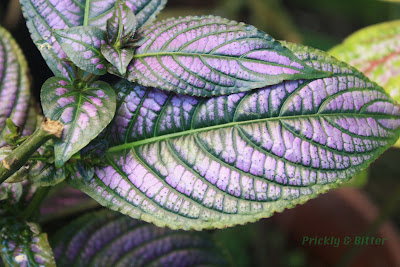Saturday, January 12, 2013
A plant needing protecting
Species name: Strobilanthes dyerianus
Common name: Persian strobilanthes, persian shield
Location: UWO Greenhouse
This species of plant, with a rather uninformative common name (it's always nice when a Latin name becomes a common name, but is rather uninformative when it comes to conveying to the public what a plant looks like), is native to Myanmar (Burma). There has been very little recently undertaken ecological surveys of Burma (the most recent was by the Smithsonian in 2003) because of government hostility, but there are a few things we do know about the forest cover of the country: it's decreasing at a dramatic rate. Up until about 1995, the tropical rain forest of Burma was pristine and almost completely untouched. The mangrove forests along the coastline were intact around the coast of the entire country (which is quite large), and the dry, arid deserts were completely preserved. Then, something happened. There was a forestry law introduced to the legislature that allowed for intense logging for export (and to use within the country), and now only about 49% of the forest cover remains. Due to various reasons (major natural disasters like typhoons and tsunamis, along with deforestation), almost all of the mangrove forests along the coast are gone. The only place that they remain intact is near the border of Vietnam, and only because to Vietnam that's a nationally protected area. Due to rice and opium production (Burma is the second largest exporter of opium around the world, next to Afghanistan; this is for the legal and illegal trade), the majority of arable land on hillsides has been deforested and converted to agriculture space. In the Dry Zone in central Burma, the land has been almost completely cleared for agriculture (which has failed for almost every crop attempted). Where large tropical fauna once roamed (rhinos, buffalo, tigers, leopards, and elephants) they are now rarely found or only found in captivity (elephants are used in agriculture and as circus performers). It's a disaster of epic proportions, and not just for the flora of the country. One has to assume now that the native flora of Burma is on its way to endangerment.
The leaves on this plant are absolutely magnificent. They are the most unique shade of purple for a plant species, and not just on the top of the leaves. The entire bottom surface is full of anthocyanins, which give the leaves their purple colour (same chemicals responsible for the purple-red colour of beets). For the sheer attention it grabs, this plant has become an incredibly popular ornamental plant in recent years. If it ever reaches flowering (it can be grown in a container in more northern climates as an annual plant, or overwintered indoors), the flowers are white but don't have much of a scent. I didn't realize it at the time, but I bought one of these plants at a local grocery story nursery when I was an undergrad, and successfully killed it in a few short months (I had a lot to learn about gardening and taking care of plants when I was twenty...). At first it was a very vigorous grower, but then it just kind of petered out before keeling over and turning brown and crunchy. I named all of my plants, and this one was Sven. And now I even know why he died! These plants are incredibly sensitive to chlorinated water. When I was watering poor Sven, I was using regular tap water, which in my residence building tasted like it had been freshly drained from the Campus Recreation pool. Whoops! To those of you with backyard pools, you might want to consider different container or landscape plants if you have visitors that are good at canon balls. And if you have this as an indoor plant, use filtered water if you know your tap water has a lot of chlorine in it.
Other than the obvious ornamental value, this plant has no known other uses. I can imagine it would be a great plant to use as a dye since the leaves are so purple, but I'm not sure it has ever been used for this purpose.
Subscribe to:
Post Comments (Atom)





No comments:
Post a Comment